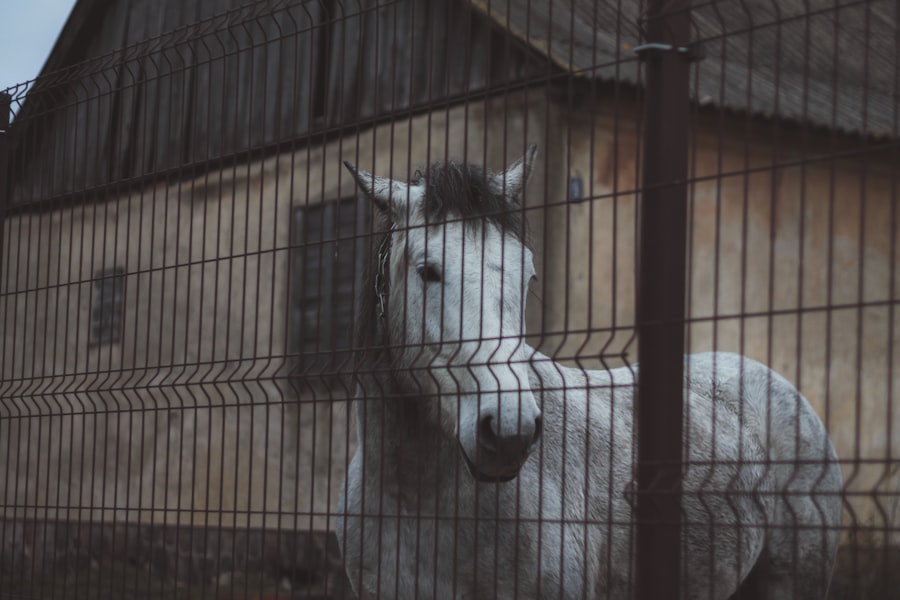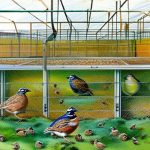Proper quail breeding cage dimensions are crucial for the health and productivity of your quail flock. The size of the cage directly impacts the well-being of the birds, their ability to breed, and the quality of the eggs they produce. Inadequate space can lead to stress, aggression, and even cannibalism among the quail. On the other hand, providing the right amount of space can reduce these negative behaviors and promote a healthier and more productive flock.
Additionally, proper cage dimensions are essential for maximizing the breeding potential of your quail. When quail are provided with adequate space, they are more likely to engage in natural breeding behaviors, resulting in higher fertility rates and better hatching success. This is especially important for commercial quail breeders who rely on high egg production and hatch rates for their business. In summary, proper quail breeding cage dimensions are essential for promoting the overall well-being and breeding success of your quail flock.
Table of Contents
- 1 Factors to Consider When Determining Quail Breeding Cage Dimensions
- 2 Recommended Quail Breeding Cage Dimensions for Different Breeds
- 3 The Impact of Cage Dimensions on Quail Health and Productivity
- 4 Tips for Building or Purchasing Quail Breeding Cages with the Right Dimensions
- 5 Common Mistakes to Avoid When Determining Quail Breeding Cage Dimensions
- 6 Adjusting Quail Breeding Cage Dimensions for Different Stages of the Breeding Process
- 7 FAQs
- 7.1 What are the ideal dimensions for a quail breeding cage?
- 7.2 Why are these dimensions recommended for quail breeding cages?
- 7.3 Can the dimensions of the quail breeding cage be adjusted?
- 7.4 What materials are commonly used for quail breeding cages?
- 7.5 Are there any specific requirements for the design of quail breeding cages?
Key Takeaways
- Proper quail breeding cage dimensions are crucial for the health and productivity of quail.
- Factors to consider when determining quail breeding cage dimensions include the breed of quail, the number of quail, and the available space.
- Recommended quail breeding cage dimensions vary for different breeds, with larger breeds requiring more space than smaller ones.
- Cage dimensions have a significant impact on quail health and productivity, affecting their behavior, stress levels, and egg production.
- When building or purchasing quail breeding cages, it is important to consider the right dimensions to ensure the well-being and success of the quail.
Factors to Consider When Determining Quail Breeding Cage Dimensions
When determining the dimensions of quail breeding cages, there are several factors that need to be taken into consideration. Firstly, the breed of quail being housed will impact the space requirements. Larger breeds such as jumbo quail will require more space compared to smaller breeds like coturnix quail. Additionally, the age and sex of the quail should also be considered. Adult birds will require more space than chicks, and males may need more space to reduce aggression.
Another important factor to consider is the purpose of the breeding cages. For example, if the cages are intended for egg production, they will need to be designed to accommodate nesting boxes and provide enough space for the quail to lay eggs comfortably. Furthermore, the number of quail being housed in each cage will also impact the dimensions required. Overcrowding can lead to stress and aggression, so it’s important to provide enough space for all the birds to move around freely. Overall, when determining quail breeding cage dimensions, it’s important to consider the breed, age, sex, purpose, and number of quail being housed.
Recommended Quail Breeding Cage Dimensions for Different Breeds
The recommended quail breeding cage dimensions can vary depending on the breed of quail being housed. For coturnix quail, which are one of the most popular breeds for commercial production, the recommended minimum cage size is 1 square foot per bird. However, providing more space, such as 2-3 square feet per bird, can lead to better breeding results and overall bird welfare. Jumbo quail, on the other hand, require more space due to their larger size. The recommended minimum cage size for jumbo quail is 2-3 square feet per bird.
For button quail, which are smaller in size compared to coturnix and jumbo quail, the recommended minimum cage size is 0.5 square feet per bird. It’s important to note that these are just minimum recommendations, and providing more space is always beneficial for the well-being and productivity of the quail. Additionally, when housing different breeds together, it’s important to consider the space requirements of the largest breed to ensure that all birds have enough space to thrive. In summary, recommended quail breeding cage dimensions vary for different breeds, but providing more space than the minimum requirements is always beneficial.
The Impact of Cage Dimensions on Quail Health and Productivity
The impact of cage dimensions on quail health and productivity cannot be overstated. Inadequate space can lead to a range of health issues and negative behaviors among quail. Stress-related problems such as feather picking, aggression, and cannibalism are more likely to occur in overcrowded conditions. Additionally, cramped living spaces can lead to poor air quality and an increased risk of disease transmission among the birds.
On the other hand, providing the right amount of space can have a positive impact on quail health and productivity. When quail are housed in appropriately sized cages, they are less likely to exhibit stress-related behaviors and are more likely to engage in natural breeding activities. This can lead to higher fertility rates, better egg production, and improved hatching success. Overall, proper cage dimensions play a crucial role in promoting the overall health and productivity of a quail flock.
Tips for Building or Purchasing Quail Breeding Cages with the Right Dimensions
When building or purchasing quail breeding cages, there are several tips to keep in mind to ensure that they have the right dimensions. Firstly, consider the future growth of your flock and build or purchase cages that can accommodate this growth. It’s better to have slightly larger cages than necessary than to have to upgrade or replace them as your flock expands.
Additionally, consider the ease of cleaning and maintenance when designing or selecting cages. Cages with removable trays or easy access to nesting boxes will make it easier to keep the environment clean and hygienic for your quail. Furthermore, if you are housing multiple breeds or ages of quail together, consider adjustable or modular cage designs that can accommodate different space requirements.
Finally, if you are building your own cages, make sure to use materials that are durable and easy to clean. Avoid using materials that can easily harbor bacteria or are difficult to sanitize. By keeping these tips in mind, you can ensure that you build or purchase quail breeding cages with the right dimensions for your flock.
Common Mistakes to Avoid When Determining Quail Breeding Cage Dimensions

When determining quail breeding cage dimensions, there are several common mistakes that should be avoided to ensure the well-being and productivity of your flock. One common mistake is underestimating the space requirements of different quail breeds. It’s important to research and understand the specific needs of each breed in order to provide adequate space for them to thrive.
Another mistake is overcrowding cages in an attempt to maximize space or reduce costs. Overcrowding can lead to stress, aggression, and poor breeding results among quail. It’s important to prioritize the well-being of the birds over maximizing space usage in order to maintain a healthy and productive flock.
Additionally, failing to consider future growth or changes in your flock size can lead to having to upgrade or replace cages down the line. It’s important to plan ahead and build or purchase cages that can accommodate potential changes in your flock size.
Finally, neglecting proper ventilation and air quality within the cages can have a negative impact on quail health and productivity. It’s important to ensure that cages are well-ventilated and provide a clean and healthy environment for the birds.
Adjusting Quail Breeding Cage Dimensions for Different Stages of the Breeding Process
It’s important to adjust quail breeding cage dimensions for different stages of the breeding process in order to promote successful breeding outcomes. For example, during the egg-laying stage, providing nesting boxes within the cages is essential for creating a comfortable environment for hens to lay their eggs. This may require additional space within the cages compared to other stages of the breeding process.
During incubation and hatching, it’s important to provide enough space within the cages for brooding areas where newly hatched chicks can stay warm and safe. This may require temporary adjustments to cage dimensions or providing separate brooding areas outside of the main cages.
Additionally, as chicks grow into adults, their space requirements will increase. It’s important to plan for this growth and provide enough space within the cages for adult birds to move around comfortably.
Overall, adjusting quail breeding cage dimensions for different stages of the breeding process is essential for promoting successful breeding outcomes and maintaining a healthy and productive flock. By considering these adjustments throughout the breeding process, you can ensure that your quail have the space they need to thrive at every stage of their development.
If you’re interested in quail breeding cage dimensions, you may also want to explore the article on “What is the Incubation Period for Goose Eggs” on PoultryWizard.com. Understanding the specific needs of different poultry species can be crucial for successful breeding and raising. Check out the article here to gain insights into the incubation period for goose eggs and enhance your knowledge of poultry breeding.
FAQs
What are the ideal dimensions for a quail breeding cage?
The ideal dimensions for a quail breeding cage are 24 inches in length, 24 inches in width, and 10 inches in height. This provides enough space for the quails to move around and breed comfortably.
Why are these dimensions recommended for quail breeding cages?
These dimensions are recommended to provide enough space for the quails to move around, breed, and lay eggs comfortably. It also allows for proper ventilation and easy cleaning of the cage.
Can the dimensions of the quail breeding cage be adjusted?
Yes, the dimensions of the quail breeding cage can be adjusted based on the number of quails being housed and the available space. However, it is important to ensure that the cage still provides enough space for the quails to move around and breed comfortably.
What materials are commonly used for quail breeding cages?
Common materials used for quail breeding cages include wire mesh, wood, and plastic. Wire mesh is often used for the sides and top of the cage to allow for ventilation, while wood or plastic may be used for the base and frame of the cage.
Are there any specific requirements for the design of quail breeding cages?
Quail breeding cages should have a solid base to provide a comfortable surface for the quails to walk on and lay eggs. The cage should also have a secure door or opening for easy access to the quails and their eggs. Additionally, the cage should be designed to allow for easy cleaning and maintenance.
Meet Walter, the feathered-friend fanatic of Florida! Nestled in the sunshine state, Walter struts through life with his feathered companions, clucking his way to happiness. With a coop that’s fancier than a five-star hotel, he’s the Don Juan of the chicken world. When he’s not teaching his hens to do the cha-cha, you’ll find him in a heated debate with his prized rooster, Sir Clucks-a-Lot. Walter’s poultry passion is no yolk; he’s the sunny-side-up guy you never knew you needed in your flock of friends!







